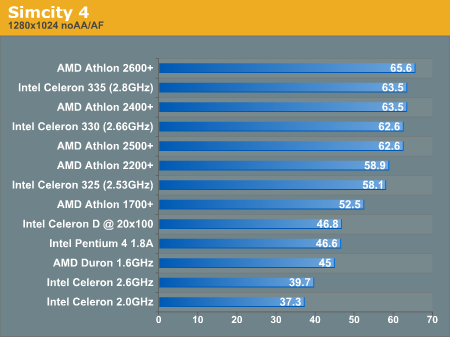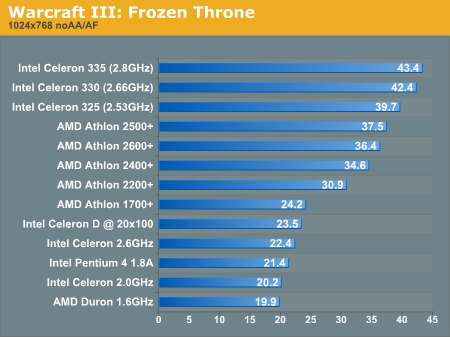Intel Celeron D: New, Improved & Exceeds Expectations
by Derek Wilson on June 24, 2004 3:01 AM EST- Posted in
- CPUs
DirectX 8 Gaming Performance
Once again, in all but Simcity, the top Celerons take the lead. In Warcraft III, the Athlons have a significant performance advantage over the Northwood Celerons, and the slowest Prescott Celeron has a 5.8% lead over the fastest Athlon.In looking at the 20x100 Celeron D, we can see that the core and L1 cache enhancements provide a more than 16% performance advantage under Warcraft III. In light of the performance of the Pentium 4 flavor of Prescott, this is simply remarkable.













54 Comments
View All Comments
Minot - Thursday, June 24, 2004 - link
Can we get a comparison of a P4 2.4A (Prescott, 1MB L2 cache, 533 MHz FSB) compared to these new Celeron D processors?Pumpkinierre - Thursday, June 24, 2004 - link
Yeah, there's something more to this than meets the eye. I dont really follow your cache arguments, Derek (and I'm known not to like caches when they are irrelevant). To me what applied to the P4E applies to the celeron D. Its a pity you didnt throw in a 533MHz 2.8E in your benchmarks. I predicted the Prescott celeron would be a good buy but more on the basis of less heat and better o'clocking. The only conclusion I can come of all this, is the Prescott core is better than we think but the cache structure is the problem. Else they've changed something in the pipeline architecture of these celeron Ds which may have ramifications for later stepping P4Es.TrogdorJW - Thursday, June 24, 2004 - link
#39 - Oh. Dang. Oops. Still, I think I probably would have chuckled more than anything. Who here hasn't made a major mistake at some point in their life? The only problem is that with Internet "publishing", your mistake can be put on the web in minutes rather than days.Wonder how many "Flame AnandTech" threads have started up on other hardware forums about the original article?
TrogdorJW - Thursday, June 24, 2004 - link
Just out of curiosity, what's the actual transistor count and die size of the Celeron D?With the trimmed down L2 cache, that cuts out about 40 million transistors. If they removed dormant 64-bit stuff from the Prescott core as well (or some other unnecessary additions), we're down to almost the same transistor count as Northwood, except with a 90 nm process.
Even with 75 million transistors, if it still uses 8 layers like Prescott (and not 6 like Northwood), that would put the die size at less than 70 mm2 by my calculations. Yowza!
Picture this: 70 mm2 die size CPUs on 300 mm wafers. That gives an absolute maximum of 1009 CPUs per wafer, minus those that are on the outer edge (i.e. partial cores). Even with conservative yields of 60%, we're talking about roughly 600 CPUs per wafer. No wonder they're so cheap.
DerekWilson - Thursday, June 24, 2004 - link
Unfortunately, TrogdorJW, most of the premise of the original publishing was based around the assumption that the Celeron D was able to out perform its predecessor inspite of having an equal sized cache.It was a very large error, and certainly worthy of the outrage people have voiced.
Thanks for sticking up for us though. And please be assured that we will be much more careful. Again, we appologize for the error.
TrogdorJW - Thursday, June 24, 2004 - link
I think some overclocking results are definitely in order, though. Take the Celeron D 325 2.53 GHz part and overclock that to a 166 MHz bus and you get a 3.2 GHz (3.167 GHz) part. It would be interesting to see how that compares to the P4 3.2C and 3.2E - Sure, it will still be (a bit?) slower, but at less than half the cost!I'm guessing that a 200 MHz bus is unreachable, as that would give you 3.8 GHz. Then again, from the 915/925 roundup, it seems that 3.8 or 3.9 GHz was reached with many of the Prescott CPUs. Damn... $80 for a CPU that might actually get close to 3.8 GHz!? Either I'm dreaming - entirely possible - or we have a return of the good old 300A overclocking days! Pray for the latter!
So, seriously, let's have the overclocking results, and compare that to regular P4, Athlon XP, and Athlon 64 results.
TrogdorJW - Thursday, June 24, 2004 - link
Mino, considering that you can't even write a single sentence without spelling and/or grammar errors, I would think that calling the article "full of errors" is rather like the pot calling the kettle black. "I didn't intend to make me looka 'smart', nor is my opinion I am." Way to make yourself look even dumber! Granted, I'm looking at the corrected version of the article, but even if I had read it with the incorrect L2 cache size, it's not that big of a deal. (Unless the original article had statements along the lines of, "even with the same size cache the new Celeron D outperforms... blah blah blah..."?)mino - Thursday, June 24, 2004 - link
#32 actually U are WRONG, fastest BUDGET proc from AMD is AthlonXP 2800+ which compared to Celeron2.8(here in SK called "Zelenina"-> means "vegetable") is like horse to ponny;)However Cel. D is welcome improvement from Cel. based on Willys and Northwds. It is however move from near unusability(but like heater they were gut:) to low usability. Improved computing and heating performance is a good sign, especially ina winret nights when tey turn off heating ussually in my work :).
Xaazier - Thursday, June 24, 2004 - link
intel must be making these things cheap, 90nm process and only 256kb l2also the number of celerons sold in cheap emachines and dells is high right?
mino - Thursday, June 24, 2004 - link
#31 Eh, sorry, by "Anand" i meant shortened word "AnandTech".My mistake, won't repeat:-).